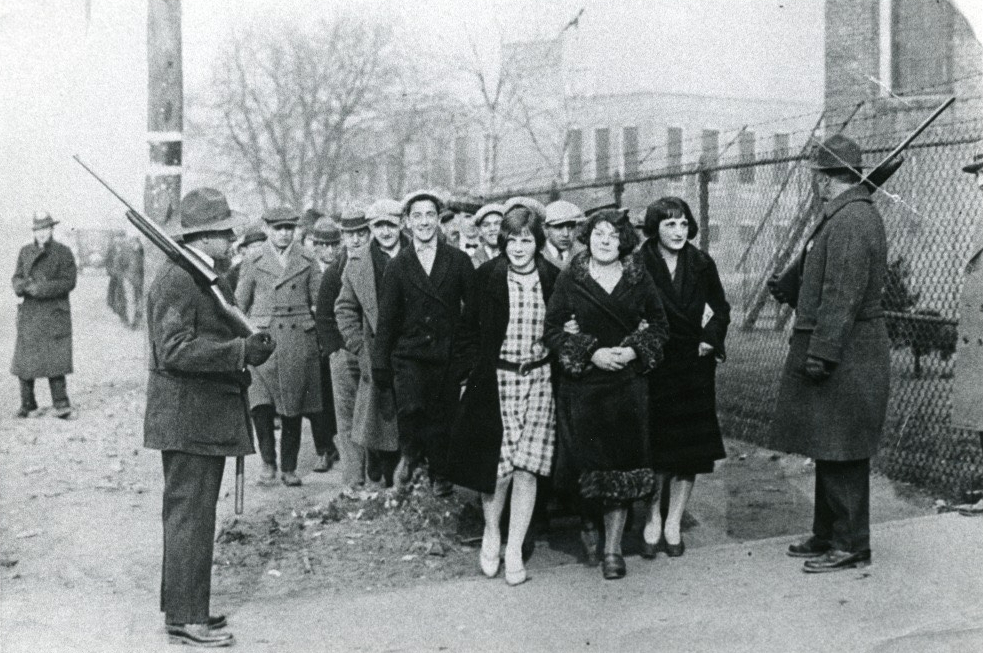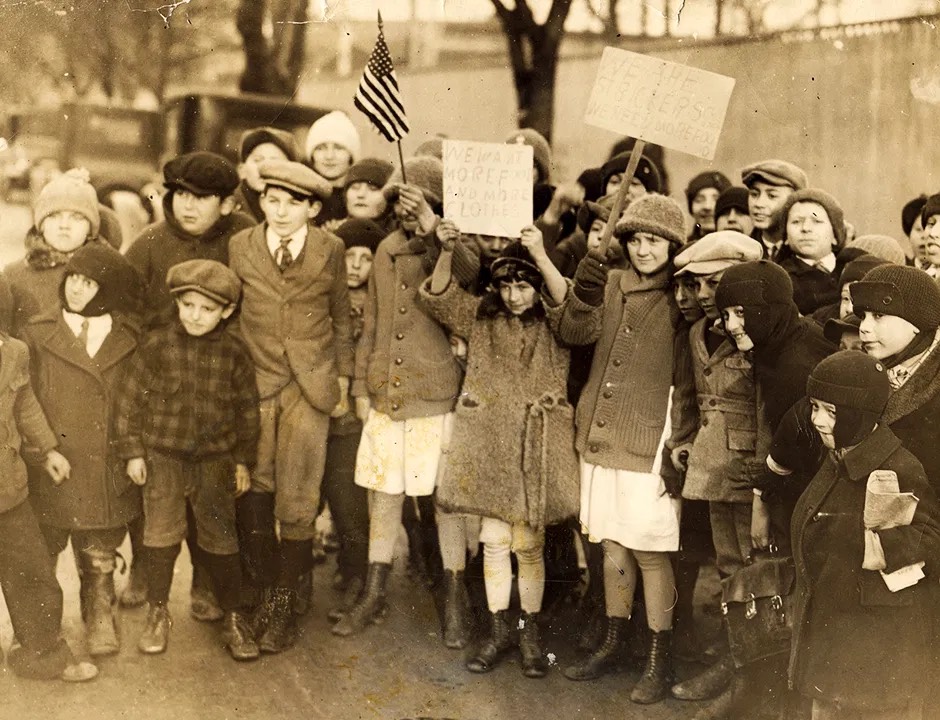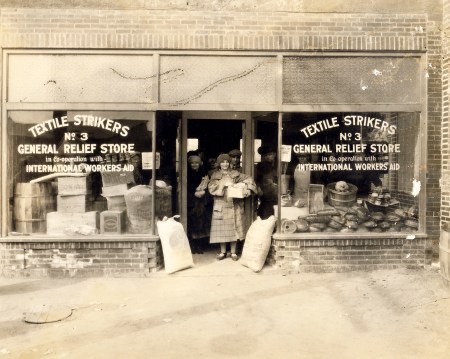Jacob Zumoff provides an in-depth account of militancy in the United States textile industry in the 1920s in a new book. The Red Thread: The Passaic Textile Strike examines a strike that played an outsized role establishing the Communist Party (CP) as a significant actor in the labor movement.
Zumoff provides an impressive trove of detail, utilizing literature from the Communist International (Comintern) archives in Moscow, as well as from papers written by participants in the strike. His narrative reveals that despite harsh economic conditions, strikebreaking bosses, conservative union officials, police brutality, and a reactionary political climate, workers can rally their forces and fight back—particularly when the Left helps take the lead.
Like the previous book by Zumoff, The Communist International And U.S. Communism: 1919-1929, his new book examines the CP in its formative years. During this period, Zumoff writes, the Comintern still intervened as a “Marxist” force, prior to complete Stalinist degeneration.
Until the 1924 death of Lenin, and for at least a few years after, the CP in the U.S. prioritized the building of working-class power—even if done imperfectly. After Stalin consolidated control of the Comintern, however, Communists began to subordinate the interests of the working class to the prerogatives of Soviet foreign policy, and the power and privilege of the rising Soviet bureaucracy.
In 1926 this transformation had not yet been consummated, and the CP in the U.S. was still receiving direction from the Comintern along revolutionary socialist lines.
Intra-party factionalism played a role in the direction of the Passaic strike. However, spirited debate was a testament to the democratic culture that prevailed within the nascent CP.
Moreover, Communists stepped in to lead where the mainstream labor movement would not. This deserves high marks. Today, when millions of workers remain unorganized, and the American Federation of Labor and Congress of Industrial Organizations (AFL-CIO) bureaucracy is apathetic, this is worth paying attention to.
Red Thread also underscores the importance of strike strategy. While it may be hard to believe now, strikes were once taken for granted as the accepted method of defending workers wages and conditions, as well as for taking the offensive and making new demands.
The role of the Left in helping to lead the labor movement, and resurrection of the strike as a general strategy for fighting the bosses, are two questions Red Thread forces us to grapple with.
Context for Communist leadership
A quarter of New Jersey workers in 1915 eked out a squalid living in textiles, an industry with a rich history of militancy. Silk dye workers had gone out on strike in 1890, 1894, 1902, 1905, and 1913. Most of these battles included demands for union recognition and ended in defeat. Police brutality, company espionage, and “AFL indifference” undermined these unionization attempts, but harsh conditions continually pushed workers into struggle.
52 percent of Passaic workers were immigrants, and half were women. These workers had more in common with mass production workers in steel and auto than they did with those in the skilled trades.

Textile barons preferred that their workers not learn English, thinking this was a bulwark against collectivism. The CP was well-positioned to intervene in this milieu given the high density of immigrants making up its many foreign language federations. The Passaic strike was also an important step for U.S. Communists—it helped transform a largely isolated, immigrant organization into a strategically placed and diverse bastion of U.S. workers.
Established unions were not much better than the bosses, in some regards. Elitist craft union leaders atop the AFL looked down on Passaic workers, and made their support conditional on the Passaic strikers distancing themselves from Leftists.
Most issues of the AFL-affiliated United Textile Workers (UTW) journal, Textile Worker—even during the strike—included advertisements from mills that the union should have been organizing. Zumoff writes, “the Passaic mills subsidized the UTW through such advertisements, and the UTW in turn left the mills unorganized.” This lack of leadership left a vacuum that the CP was willing and able to fill.
The strike begins
On September 25, 1925, workers at Botany Worsted Mills and Garfield Worsted Mills found a note attached to the front gates informing them that pay would be cut 10 percent. This sign set the Passaic textile strike in motion.
Workers began walking out on January 22, 1926. By spring the strike peaked at 16,000 workers from multiple mills in Passaic and nearby towns. Like most strikes in the 1920s, it began defensively. However, as the struggle gained momentum and attracted support, workers would switch gears to mount an offensive.
The demands of the strikers included a raise in wages, time-and-a-half for overtime (which had been reduced by the bosses), sanitary conditions, union recognition, and no retaliation against union activists.
Communist publication New Masses described how picketing “became contagious” during the strike, and turned into:
Passaic’s favorite game. Children played at picketing. They picketed their schools. They picketed their homes. Children came out after school to go on the picket line.
Meanwhile, Passaic workers “defended their strike by publicizing the names of scabs and throwing red pepper at them.”

Strikers organized daily mass meetings and ran things democratically and inclusively through the direction of a hundred-worker strike committee. Every department in each mill sent delegates to this strikers’ parliament. The advanced level of rank and file democracy was crucial for workers playing a direct role in planning and execution of the strike, and for constantly assessing and reassessing strategy and tactics. Experience of collective action and the clashing of power on the shop floor clarified workers’ consciousness of their class position within the production process.
When UTW refused to lead the strike, Gustav Deak, a radical in the mills, formed the United Front Committee of Textile Workers (UFC) with co-workers to take the lead. Deak also reached out to Albert Weisbord, a CP member active in the silk industry. Deak would play a key leadership role in the strike and be an overall thorn in the side of bosses, New Jersey politicos, and liberal allies alike.
Harvard Law School graduate and recent recruit from the Socialist Party, Weisbord was described by some comrades as an “egomaniac,” but they also conceded that he had a way with workers that few could match. Weisbord was able to organize workers on the picket line over eight brutal months, enduring the harsh northeast winter, police billy clubs, and incessant red-baiting.
Organizers like Weisbord do not fall out of thin air; they are molded by the socialist movement. By the late 1920s the CP had cultivated a layer of labor cadres and it was applying a “concentration policy” in textiles, along with other select industries. Several Communist organizers were dispatched to Passaic to help lead the strike.
Communists in the labor movement
By June 1925, Zumoff estimates that the CP had 14,500 members, with 3,500 in New Jersey. “Party reports indicate that communists had been paying attention to the Paterson-Passaic textile industry since at least the fall of 1925.” A District Executive Committee meeting from that year authorized a body “to mobilize the entire [my emphasis] Paterson membership for work in the silk industry.”
The CP perspective for work in textiles provides a decent approximation of their general labor strategy. This included challenging the conservative union officialdom, organizing non-union workers, amalgamation of textile unions into one mass industrial union, making the shop committee the basic unit of labor organization, and formation of a labor party.
The goal was class-struggle unionism, “a united front of the workers against the united front of the bosses.” In some cases the CP applied this program in exemplary fashion, other times they fell short. These perspectives guided the UFC in the Passaic strike.
Communists implanted scores of members in textiles and other industries, such as auto and mining. This followed from their belief that no matter how savvy an organizer was, or how useful outside support could be, nothing substituted for a permanent presence on the shop floor. Communists understood that this was where working-class power derived from.
This highlights a contemporary problem that we have seen in recent years involving various unions attempting to organize in the U.S. South: union staffers parachute in—lead a campaign for a representation election— and then parachute out.
This has been the approach of United Auto Workers in failed attempts to win representation elections through the National Labor Relations Board process, at Nissan in Mississippi, or Volkswagen in Tennessee. More recently, this problem was repeated when the Retail, Wholesale, and Department Store Union (RWDSU) lost a NLRB election at Amazon in Bessemer, Alabama.
Maintenance of a continuous union presence when these union “leaders” leave the scene is an uncertain question. Only if we start with the idea that workers themselves are the union, can we guarantee that the union remains when the campaign is finished.

This was one of the main precepts of Communist labor strategy. Of course, the CP did not always live up to these ideals. After the Passaic strike they could count few members and supporters among the workforce. “This made it difficult to maintain a party presence in Passaic after the strike ended,” Zumoff writes.
Failure to recruit led to criticism from some that Communists “soft-pedaled” their politics, meaning that they downplayed the long game of winning workers to their political project in an effort to win leadership in the immediate campaign. Whether or not the CP did this in Passaic is an open question.
Roger Keeran speculates that the CP did do this in the auto workers’ unions around the same time frame. That was certainly the case in the CIO in the 1930s, when the CP engaged in what Kim Moody calls “permeation,” dissolving its independent shop floor cells and publications and taking staff and officer positions. This policy made it easier for CIO officials and Democratic Party operatives to purge Communist organizers when they no longer had a need for their organizational skill.
It is true that some of the same CP organizers working in Passaic were also involved in leading two needle trades strikes happening simultaneously in nearby New York City. If the Passaic strike had relied heavily on paid organizers, the strikers would have been left in a position of vulnerability—pointing again to the irreplaceability of a wide layer of radicals based in the workplace. The lessons workers learned through democratic, collective action, guided by Communist leadership, meant that seeds were planted for a new flowering of struggle. Despotism in the workplace would water the seeds.
Communist labor strategy
The Passaic strike seems to have been an important moment for a CP reappraising its trade union strategy. Ironically, the UFC was collecting dues and issuing membership cards while the CP leadership faction under C.E. Ruthenberg was insisting UFC was not a union! However, as Weisbord argued, “when no union in a particular workplace exists, AFL or otherwise, any effort to organize that workplace becomes a de facto union.”
From the 1920 publication of Lenin’s Left-Wing Communism: An Infantile Disorder, written in preparation for the Second Congress of the Comintern, the CP advocated working inside AFL unions to reach the majority of organized workers. This meant that building independent, “dual unions”, was counseled against as it would isolate militants.
What if the AFL refused to organize mass production workers, immigrants, or other oppressed groups, who were otherwise clamoring for unionization? This question confronted Communists in Passaic. The CP redefined its labor policy in July 1927 “to allow the possibility of forming separate unions through organizing unorganized workers.” Whether CP policy was right or wrong, it foreshadowed the CIO breaking away to organize industrial workers in the 1930s.
The CP played a leading role forming UFC in the Passaic mills, but it fought throughout the strike to affiliate UFC to UTW and the AFL for the purposes of labor unity. This did not end well.

UTW and the AFL were eventually pressured into accepting the Passaic strikers as Local 1603, but the labor bureaucrats had no plans to put any resources into a Communist-led union. This neglect was accompanied throughout the strike by vicious red-baiting of CP organizers, particularly Weisbord, who was eventually forced out of the strike by both the textile bosses and the AFL. This meant Passaic workers lost their best leader.
The CP did not deal honestly with the situation, and sold integration into the UTW—which resulted in neither union recognition nor collective bargaining—as an unadulterated victory. Zumoff rightly argues that the CP “sought to deflect anti-Communist attacks by reducing the party’s profile in Passaic,” which “meant that the party had a weaker base” during the final stages of the strike. Initially, the CP had hoped to raise its profile in Passaic and to recruit the most radical workers; but by downplaying instead of confronting red-baiting, it did the opposite.
However, as CP member and future Trotskyist leader James P. Cannon conceded: an independent Communist-led union would likely have been too weak to take on the textile industry by itself. This fact compelled the UFC to seek integration into the UTW, but by claiming victory, the need to continue the struggle for union recognition was de-emphasized.
Strike leadership
The way the CP ran the strike is another story. The outreach work the UFC did during the Passaic strike was commendable, and provides instructive examples for how the Left could approach labor organizing today. Communists tried to constantly expand the strike zone by bringing in other workers from the industry, “no matter the job title or description.” Their attempt to organize the unorganized in the immediate vicinity of the strike—and even throughout the region—not only added support and raised publicity, but it also undercut efforts at scabbing. As has often been the case throughout labor history, the strike itself was an organizer.
In every attempt at mediation, the UFC was willing to negotiate, but never in a way that would demobilize workers. CP organizers made sure to involve the rank and file in every phase of bargaining. It was made abundantly clear that “the resolution of the strike would come through workers’ power on the picket line, not the goodwill of capitalist politicians,” Zumoff writes.
The UFC, CP, and coalition of radical and liberal allies organized to support the strike did phenomenal work, but “these efforts aimed to supplement, not substitute for, strong workers’ picket lines to shut down production.” Communist Alfred Wagaknecht, who was in charge of relief, believed that “relief can lose a strike as well as win it,” and that relief and militancy should not be seen as separate things, but supplemental.

Conclusion
As Zumoff writes, “there is little memory” of the Passaic strike today. When mentioned at all, it is usually confused with the famous 1913 Paterson silk strike, led by the Industrial Workers of the World. Later CP members and fellow-travelers, who had mostly succumbed to Stalinism, had “no wish to look back as that would require comparing the CP of the 1920s with what it had become.”
Communists should be praised for organizing Passaic textile workers when nobody else would, their class-struggle tactics, their commitment to rank and file unionism, and fidelity to placing the most oppressed workers at the center of struggle.
However, as Zumoff argues, joining the UTW should have provided the organizational basis to build a more durable, fighting union when the next round of struggle broke out. It is possible that a fight for union recognition could fall short, but still maintain the basis for further militancy. That would have required the CP to face the situation honestly, and stage what Communist labor leader William Z. Foster referred to as an “orderly retreat.”
Just as RWDSU leader Stuart Appelbaum described the election defeat at Amazon this spring as a victory before the votes were even tallied, the CP hailed the August 1926 takeover of UFC by UTW as a triumph, even though Passaic workers had lost the fight for union recognition.
Zumoff observes that little has changed in Passaic today. As of 2011, over 18,500 people in Passaic County were employed in manufacturing, “a greater number than in any other sector except healthcare and retail.” The languages spoken may have changed, but Passaic is still an immigrant city. The labor movement looks similar as well. Zumoff writes:
Between 1954 and 2018, the proportion of the national workforce that belonged to unions declined from 35 percent to 10.5 percent—not far off from the 7.5 percent of workers who belonged to unions in 1930. In 1928, income inequality peaked in the United States—unmatched until 2013.
To make matters worse, the contemporary union leadership and a good part of the socialist movement “look to the government,” not the strength of rank and file and unorganized workers to regenerate the labor movement.
Many socialists today are lobbying capitalist politicians to champion pro-worker legislation like the PRO Act through activities such as phone-banking. History shows us, however, that the self-activity of workers typically precedes, and labor law reform follows, not the reverse.
Ruling class politicians will likely never concede power without a serious threat posed to their very existence. Reforms such as the 1935 Wagner Act were won not only through a movement of millions of workers, but also because an independent Left had a base in that movement and posed a radical alternative.
Communist labor strategy in the late 1920s offers some positive examples. While the 1926 Passaic strike was defeated, it had a big impact on class consciousness and put Communists on the map of the labor movement. Important aspects of the strike also foreshadowed facets of the 1934 city-wide general strikes, and the CIO upsurge a couple years later: industrial unionism, militant tactics, and radical politics.
Red Thread is a riveting deep-dive into that history. Let us hope our upsurge is coming. We have work to do to prepare.
Featured Image Credit: New Bedford Guide. Modified by Tempest.

